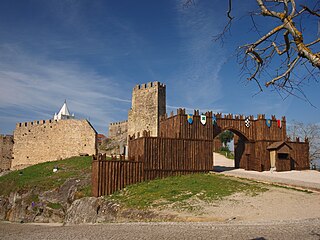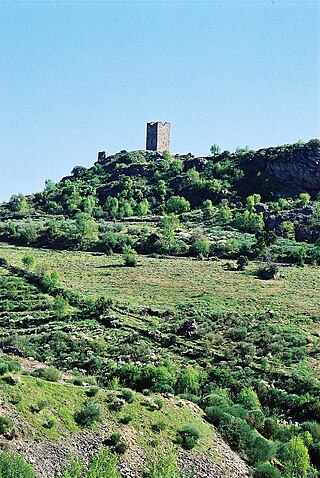
São Jorge Castle, sometimes known in English as Saint George's Castle, is a historic castle in the Portuguese capital of Lisbon, located in the freguesia of Santa Maria Maior. Human occupation of the castle hill dates to at least the 8th century BC while the oldest fortifications on the site date from the 2nd century BC. The hill on which Saint George's Castle stands has played an important part in the history of Lisbon, having served as the location of fortifications occupied successively by Phoenicians, Carthaginians, Romans, and Moors, before its conquest by the Portuguese in the 1147 Siege of Lisbon. Since the 12th century, the castle has variously served as a royal palace, a military barracks, home of the Torre do Tombo National Archive, and now as a national monument and museum.

Castle of Penela is located in a Penela town in Penela Municipality in Coimbra District, Portugal. The castle was built on a hill dominating the area and used to be a stronghold protecting Coimbra in times of Reconquista. Castle of Penela and the neighboring castle Montemor-o-Velho are both fine examples of defensive structures of that period.

The Castle of Viana do Alentejo is a gothic castle constructed during the reconquest and settlement of the central region of the Portuguese Alentejo, located in the parish of Viana do Alentejo, municipality of the same name. Although a relatively low-profile design, in comparison to its contemporaries, the structure served the period of strife associated with expansion of Portuguese forces/authority into the southern Algarve.

The Castle of Santa Maria da Feira is a Portuguese castle in the municipality of Santa Maria da Feira, district of Aveiro. Emblematic of Portuguese medieval military architecture, the Castle of Santa Maria da Feira is one of the monuments that best reflects the diversity of defenses used during the Middle Ages, having been instrumental in the process of Reconquista and autonomy of the County of Portugal. It has been listed as a National monument since 1910.

The Castle of Castelo Rodrigo is a medieval castle in the civil parish of Castelo Rodrigo in the municipality of Figueira de Castelo Rodrigo, district of Guarda in Portugal.

The Castle of Terena is a castle in the civil parish of Terena in the municipality of Alandroal in the Portuguese subregion of Alentejo Central. Since 1946, it has been listed as a National monument.

The Castle of Alandroal is a medieval castle in the civil parish of Alandroal, São Brás dos Matos e Juromenha, municipality of Alandroal, Portuguese district of Évora, classified as a National Monument.

The Castle of Beja is a medieval castle in the civil parish of Beja, municipality of Beja, Portuguese district of Beja.

The Castle of Monsanto is a medieval castle located in the civil parish of Monsanto e Idanha-a-Velha, in the municipality of Idanha-a-Nova, Portuguese district of Castelo Branco.

The Castle of Redondo is a medieval castle located in the civil parish of Redondo, in the municipality of Redondo, Portuguese Évora.

The Castle of Mourão is a well-preserved castle in the town of Mourão, Portugal. It is classified by IGESPAR as a Site of Public Interest.

The Castle of Pombal is a medieval castle in the civil parish of Pombal, municipality of the same name in the district of Leiria in the Centre region of Portugal.

The Castle of Avis is a Portuguese medieval castle in civil parish of Avis, in the municipality of the same name, in the Alentejo district of Portalegre.

The Castle of Vinhais is a medieval castle located in the civil parish of Vinhais, municipality of Vinhais, Portuguese district of Bragança.

The Castle of Penedono is a medieval castle located in the civil parish of Penedono e Granja, in the municipality of Penedono, Portuguese district of Viseu.

The Castle of Óbidos is a well-preserved medieval castle located in the civil parish of Santa Maria, São Pedro e Sobral da Lagoa, in the portuguese municipality of Óbidos. Historical province of portuguese Estremadura.

The Castle of Penas Roias is a Portuguese medieval castle in the civil parish of Penas Roias, municipality of Mogadouro, in the Portuguese of district of Bragança.

The Castle of Mogadouro is a medieval castle located in the civil parish of Mogadouro, Valverde, Vale de Porco e Vilar de Rei, in the municipality of Mogadouro, Portuguese district of Bragança.

The Castle of Noudar is a Portuguese medieval castle in the civil parish and municipality of Barrancos, in the district of Beja.






















